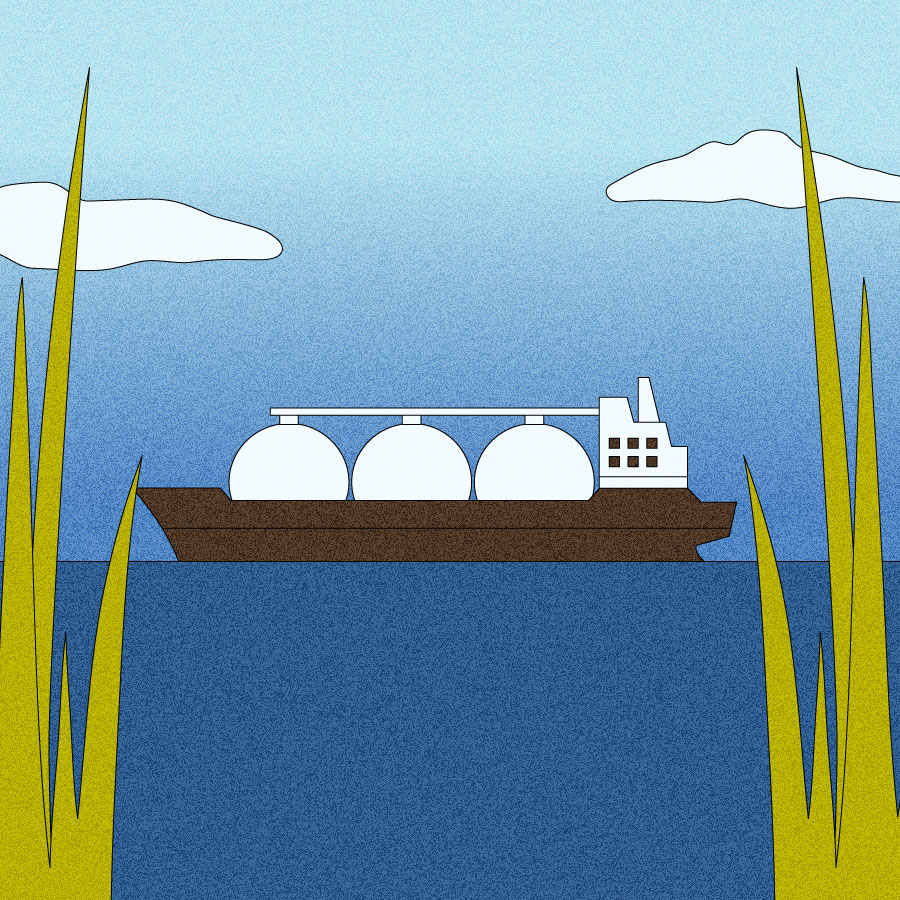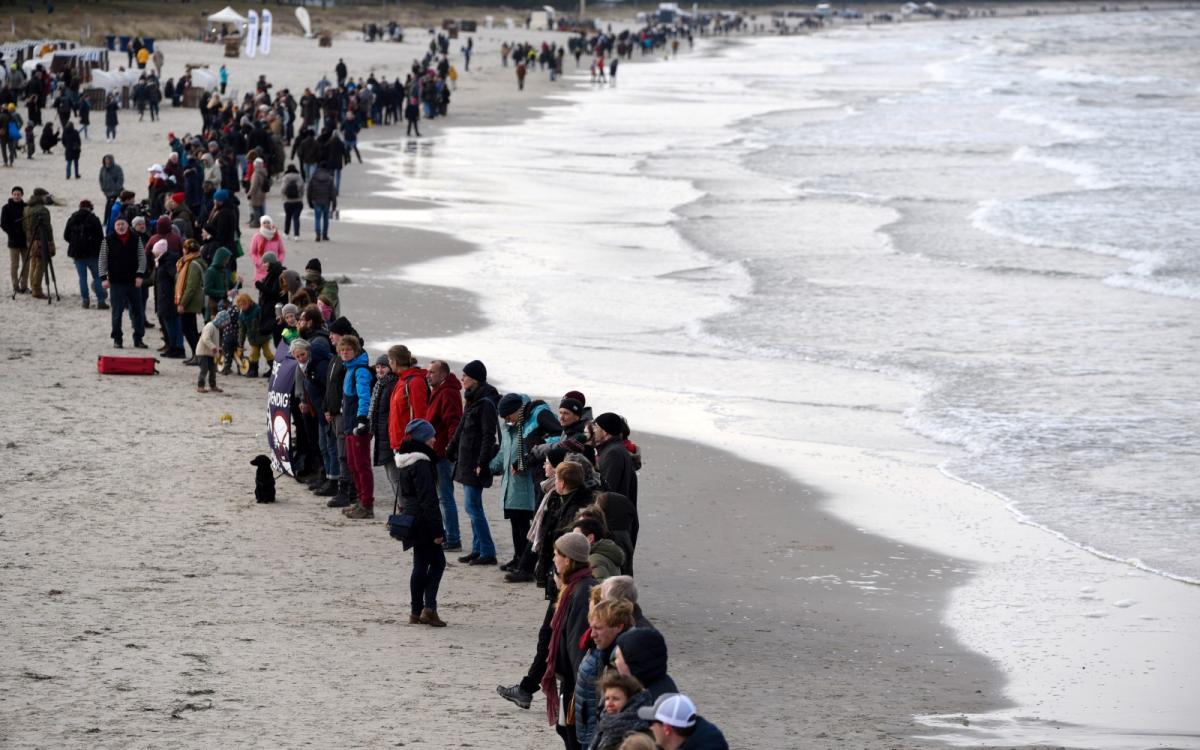
The vision
“Our community, we want to envision an alternative economy that doesn’t exploit the region, that doesn’t use our people as cheap labor, that doesn’t pollute the environment, that doesn’t accelerate climate change.”
Bekah Hinojosa, an organizer in Brownsville, Texas
The spotlight
The U.S. energy mix is heavily reliant on natural gas. It makes up the greatest share of electricity generation and home heating fuel use in the country. Over the past decade, the U.S. has also become the world’s leading exporter of natural gas, building out extensive infrastructure to convert the fuel into a form that’s easier to store and transport — liquefied natural gas, or LNG — and ship it to markets in Europe. More projects are in the pipeline, which could nearly double the country’s export capacity by the end of this decade, if approved by the Department of Energy.
But in January, the Biden administration announced a pause on approvals for new LNG terminals — a move that has been largely applauded by climate advocates and local leaders in the Gulf Coast, where the majority of current and proposed terminals are located. During the pause, the DOE will review the impacts of exporting natural gas on both domestic energy prices and the climate.
Natural gas is 70 to 90 percent methane, a greenhouse gas that’s about 30 times more potent than carbon dioxide in the short term. It’s also prone to leaking along its supply chain, which contributes to global heating and creates pollution and explosion risks for communities living near this infrastructure. But even in the course of typical operations, these terminals cause hazardous pollution from flares that burn off excess gas, from the massive amounts of fuel required to liquefy the gas, and from increased ship traffic.
Louisiana activist (and Grist 50 honoree) Roishetta Ozane told Grist reporters that the administration’s decision “shows that the government recognizes the need to protect the rights and well-being of [Gulf] communities.”
Communities like Ozane’s already face some of the worst pollution in the nation from the petrochemical industry, and LNG terminals threaten to worsen an already disproportionate burden. For some other communities, the battle against the LNG industry represents a last-ditch effort to prevent that same fate.

A construction site for a pipeline to bring gas to the Cheniere liquefied natural gas facility, which opened in 2018 near Portland, Texas. Houston Chronicle/Hearst Newspapers via Getty Images
“We’re a Gulf Coast community, but our community doesn’t look like the rest of the Gulf Coast,” said Bekah Hinojosa, an organizer in the city of Brownsville in Texas’s Rio Grande Valley (who was featured on our 2022 Grist 50 list). “We don’t have existing fossil fuel refineries here. Our port doesn’t look like the Houston ship channel. This is the first big industry trying to move into our low-income community.”
She and other local advocates have been fighting two major projects: Texas LNG and Rio Grande LNG, with the accompanying Rio Bravo pipeline that would bring fracked gas to the latter. These projects already have authorization from the Department of Energy, meaning that they won’t be halted by the Biden administration’s pause. But Hinojosa and her fellow advocates are continuing to wage their own defense. Their efforts have already yielded one victory in 2021 when a third project in the area, Annova LNG, was canceled, and they’ve successfully pressured customers and investors to back away from the others.
We spoke with Hinojosa to learn about the tools local communities like hers are using to push back against LNG expansion, as well as the fossil fuel-free future she hopes to create for her area. Her responses have been edited and condensed for clarity.
![]()
Q. What are some of the primary concerns with LNG in the Rio Grande Valley?
A. Our coastal communities in this region are 100 percent against LNG. (Editor’s note: These 2015 articles from the Port Isabel Press offer a sense of the scale of local opposition to LNG projects.) They’ve passed city resolutions against LNG [in] communities that are down the street from Brownsville: Port Isabel, South Padre Island, Laguna Vista, Long Island Village. And they oppose LNG because it would completely destroy their way of life. Their local economies depend on shrimping and fishing and nature and ecotourism. People come here from all over the world to see sea turtles, to hike and fish and shrimp and enjoy our unique wetlands. That’s what the economy of our coastal communities thrives on. And LNG would destroy that. They would dump pollution into the ship channel where shrimp lay their eggs, [and they would] dump pollution into our low-income communities.
We don’t have good health care here. People can’t afford expensive medical bills. That’s why the communities oppose the LNG projects.
Then we have the Carrizo/Comecrudo tribe, which are the original Indigenous people of this region. They oppose LNG because these projects would build on sacred sites — specifically, the Texas LNG project would destroy a known sacred Indigenous site called Garcia Pasture that’s on the National Park Service’s list of historic sites. It has ancestral burial grounds, village sites, artifacts, and Texas LNG wants to build right on top of that. And they have never consulted with the Carrizo/Comecrudo tribe.
Q. In your Grist 50 profile, you described your opposition strategy as “death by a thousand cuts.” Is that still the approach — fighting on every possible front?
A. Yeah, absolutely. We are actively pressuring insurance companies to withdraw from these LNG projects, [as well as] banks, private equity. We’re trying to stop tax subsidies for these projects, trying to prevent customers, different corporations from signing contracts to import the gas. We’ve been working with communities all over the world that don’t want to see their countries involved with these projects. I mean, essentially, we’re yelling at any and every company involved with Rio Grande LNG and Texas LNG to immediately drop these projects, and doing that in solidarity with other impacted communities. We [held two protests last week outside of corporate offices], one in Houston and one in New York, to stop Rio Grande.
Q. Is there action you would like to see at the federal level, beyond the pause on new LNG exports that the Biden administration announced in January?
A. Yeah, I mean, the pause doesn’t apply to the projects that we’re fighting in Brownsville. Unfortunately, they already have their DOE authorization. So we’re still urging the Biden administration to include these projects in the pause. I went to D.C. a few days after the pause was announced, and I met with DOE officials and a White House official. I and the Carrizo/Comecrudo tribe representatives urged the DOE to include these projects in the pause and to include meaningful community engagement as the DOE is figuring out what to do after the pause — and reminded them that our communities oppose these projects.
So we’re not backing down. We’re escalating the amount of protests that we’re doing to stop these projects. We’d like to see a plan and a pathway for LNG to be phased out and not continue to be approved.
Q. You have also been active in opposing the SpaceX launch site near Brownsville. Can you tell me about some of the compounding concerns there?
A. SpaceX is another type of industry here that is harming and polluting our community — and the launchpad is just a stone’s throw away from where the LNG terminals plan to build. We’ve already seen debris from the rocket explosions fall on the proposed LNG sites. We’ve been sending comments, letters, demanding meetings about the safety hazards of SpaceX next to LNG, and we’ve been left in the dark.
We are already dealing with explosion hazards from the rocket testing every year. My entire house started to shake — I felt an earthquake because of the last SpaceX explosion in November. We saw dust fall over the community last April from another explosion. Rocket pieces have already been raining down on our neighborhoods. And then LNG has its own explosion hazards. We’ve seen the Freeport LNG explosion that sent a blast that caused someone to fall off some jetties and split their head open. So we’re dealing with compounding explosion risks. And all of these issues are related — SpaceX actually uses LNG for rocket fuel, and they are proposing to build an LNG plant in another community down here.
Q. As you’re combating these industries, what is your vision for the Gulf Coast where you live in the next five to 10 years?
A. The Carrizo/Comecrudo tribe has been buying land near the port. They have a vision of an alternative economy for our community, and that looks like supporting their culture. They want to create jobs for local people to protect their sacred sites, for people to come and learn from their tribal community. Our community, we want to envision an alternative economy that doesn’t exploit the region, that doesn’t use our people as cheap labor, that doesn’t pollute the environment, that doesn’t accelerate climate change.
So we’re going to continue advocating for that. We want the Port of Brownsville to be clean. The public officials here just don’t have much of a vision — they’ve been failing our community. So we continue to keep having forums and making our voices louder about the future that we want and need for our Gulf Coast community.
— Claire Elise Thompson
More exposure
- Read: more about the LNG industry and its impacts along the Gulf Coast (Grist)
- Read: more about the Biden administration’s pause, and the coalition that advocated for it (Grist)
- Read: more about liquefied natural gas, and the scientific debate about its climate merits as a replacement for coal (Scientific American)
- Read: more about Hinojosa’s work and the fight to stop LNG terminals in South Texas — and check out a corresponding photo essay (Canary Media)
- You can also subscribe to Canary’s free daily newsletter here, to get more stories like this exploring the energy transition and how the world is decarbonizing
See for yourself
There’s still time to nominate climate leaders for this year’s Grist 50 list! Do you know an organizer standing up to the fossil fuel industry on behalf of their community (like Bekah Hinojosa)? Or an entrepreneur working on an innovative new solution, or an artist, a chef, a policymaker, a farmer, a scientist, or another type of leader whose climate work deserves to be recognized? Use this form to tell us about them.
A parting shot
Local communities on the receiving end of natural gas exports are also resisting the construction of terminals where they live. In the town of Binz on the German island of Rügen, protestors formed a human chain on the beach last April to show their opposition to a proposed LNG terminal on the island.




